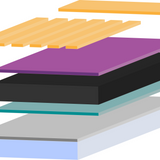How to use the Dynamic Dispense Spin Coating Method
Instructions for Dynamic Dispense Spin Coating:
- Cleaning Substrates: Start by cleaning your substrates using a UV Ozone Cleaner. Ensure they are free from contaminants.
- Substrate Placement: Place one of your cleaned substrates into the chuck and securely close the lid to prepare it for coating.
- Solution Filtering (if using PEDOT:PSS): If you are using PEDOT:PSS, it is recommended to filter the solution before dispensing. Use a hydrophilic filter for this purpose.
- Preparing Pipette: Fill your pipette with the solution you intend to use for coating.
- Setting Spin Cycle Parameters: Input the spin cycle settings on the spin coater. For optimal results with PEDOT:PSS, we recommend a speed of 6000rpm and a total time of 30 seconds. Adjust these parameters as necessary for your specific application.
- Starting Spin Cycle: Press the start button on the spin coater to initiate the spin cycle. Ensure that the chuck with the substrate is in place and secure.
- Solution Dispensing: Insert the end of the pipette into the hole directly above the substrate. Quickly and carefully squeeze some of the solution onto the substrate's surface. Ensure an even distribution of the solution.
- Waiting for Spin Cycle Completion: Wait patiently until the spin coater has completed its cycle. This typically involves spinning the substrate at the specified speed for the predetermined time.
- Substrate Removal: Once the spin coater has finished its cycle, carefully open the lid, and remove your coated substrate. Ensure that it is handled appropriately to avoid damage or contamination.
- Proceeding to the Next Substrate: If you have more substrates to coat, repeat the process by placing another cleaned substrate into the chuck. Follow the same steps, from solution preparation to spin coating, before moving on to the next one.
Spin Coater

Resources and Support
 The Ultimate Guide to Making Perovskite Solar Cells
The Ultimate Guide to Making Perovskite Solar Cells
Over the past 10 years, perovskite solar cells (PSCs) have achieved record efficiencies of 25.5% single junction solar cells (as of 20211) and these efficiencies are rising impressively.
Read more... Spin Coating: Complete Guide to Theory and Techniques
Spin Coating: Complete Guide to Theory and Techniques
Spin coating is a common technique for applying thin films to substrates. When a solution of a material and a solvent is spun at high speeds, the centripetal force and the surface tension of the liquid together create an even covering.
Read more...